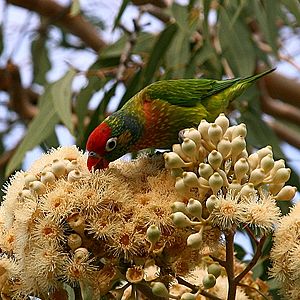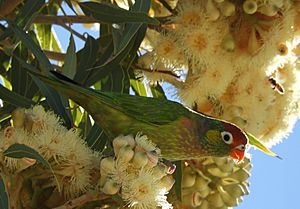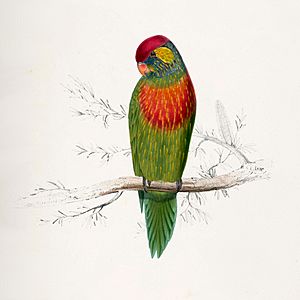Varied lorikeet facts for kids
Quick facts for kids Varied lorikeet |
|
|---|---|
 |
|
| In Queensland, Australia | |
| Conservation status | |
| Scientific classification | |
| Genus: |
Psitteuteles
|
| Species: |
versicolor
|
The varied lorikeet (Psitteuteles versicolor) is a colorful type of parrot. It belongs to the Psittacidae family, which includes many kinds of parrots. This bird lives only in the northern coastal areas of Australia.
Contents
How Scientists Classify the Varied Lorikeet
The varied lorikeet was first drawn by an artist named Edward Lear in 1831. His drawing was very important. It became known as the holotype, which is like the main example of the species. This drawing was part of his book Illustrations of the Family of Psittacidae, or Parrots.
At first, the bird was called Trichoglossus versicolor. Later, in 1854, a French scientist named Charles Lucien Bonaparte placed it in a new genus called Psitteuteles. A genus is a group of closely related animals.
The varied lorikeet is a monotypic species. This means that all varied lorikeets are considered the same type. There are no different subspecies or variations recognized by scientists.
What Does the Varied Lorikeet Look Like?
The varied lorikeet is about 19 centimeters (7.5 inches) long. It is mostly green with short yellow stripes. It has a special look with fine yellow streaks and a wide white patch around its eyes.
Its face, forehead, and the top of its head are red. The bird has a red beak and white rings around its eyes. Its eyes are orange-yellow. The upper part of its chest is a purplish-pink color with yellow stripes. Its legs are bluish-grey.
Female varied lorikeets have less red on their heads. Their chest colors are also not as bright. Young varied lorikeets are much duller. They are mostly green with an orange forehead. Their eyes are pale brown, and their beak is brown with an orange base.
When these lorikeets fly, they are very fast and fly in a straight line. They make a loud, sharp screeching sound. You can often hear a flock of them before you see them.
Reproduction and Life Cycle
Varied lorikeets usually mate between April and August. The female bird will lay 2 to 4 white eggs. They lay their eggs inside a hollow part of a tree, often in horizontal branches. These horizontal branches are also used by the lorikeets for sleeping.
Where Do Varied Lorikeets Live?
The varied lorikeet lives in tropical eucalypt forests. They also live in wetland and grassland areas. You can find them in northern parts of Queensland, the Northern Territory, and Western Australia.
Their home range stretches from Broome in Western Australia. It goes across to the Gulf region in the Northern Territory. It reaches south to Mt Isa and north to the Jardine River in Queensland.
See also
 In Spanish: Lori multicolor para niños
In Spanish: Lori multicolor para niños




